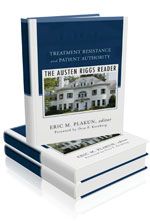
Publication
Article
Psychiatric Times
Treatment Resistance and Patient Authority: The Austen Riggs Reader
Author(s):
Contemporary psychoanalysts know that behavior is a form of communication. This book describes the work being done at the Austen Riggs Center, a psychodynamic institution in Stockbridge, Mass.
Contemporary psychoanalysts know that behavior is a form of communication.Treatment Resistance and Patient Authority: The Austen Riggs Reader,edited by Dr Eric Plakun, describes the work being done at the Austen Riggs Center, a psychodynamic institution in Stockbridge, Mass. Specializing in work with treatment-resistant, usually highly comorbid, and often high-risk patients, the Center’s intensive multimodal psychoanalytic treatment program considers the most passive, disturbed, or disturbing behavior of treatment-resistant patients as cause for hope rather than pessimism.
Treatment resistance, defined as a failure to respond to customary psychiatric treatment, is now considered a fairly common occurrence that can involve substantial suffering and disability. Almost all mental health professionals have had contact with complicated, severe cases that tax resources and discourage clinicians. Given the magnitude of the problem of treatment resistance, the impact on patients and those who care about them, and the consumption of health care resources, the subject of this book is very important indeed.
To explain the practicalities of treatment resistance, the authors of each chapter describe contemporary psychoanalytic work and transmit the attitude required for this work. Furthermore, they keep in mind an audience that may be accustomed to approaching difficult clinical problems with a very different state of mind.
Aptly titled a “reader,” the book seems designed for the ongoing development and use of certain basic skills. Like the best of “readers,” it contains elements for the ambitious student. “The Third,” for example, which is discussed throughout the book, is a term currently at the cutting edge of psychoanalytic theory. Therefore, its inclusion may be a drawback for the inexperienced or less ambitious scholar.
The text is well organized with take-home messages set apart in boxes. The phenomenon of treatment resistance is reviewed, as are data that support the positive results obtained at the Riggs Center. A variety of issues are addressed, including negative transference; the transmission of trauma; psychodynamic psychopharmacology; and working with suicidality, family resistance, and psychotic disorders.
We are urged to look beyond the phenomenon of “acting out” toward the notion of “enactment,” which implies clinician participation in the unfolding treatment-resistant behavior. From this point of view, treatment pivots around the empowering concept of authority-the patient as author of an engaged relational narrative previous-ly carried in action (and inaction) rather than in words.
The book is worth reading by all mental health professionals. Of particular interest is the chapter “What is psychodynamic psychopharmacology? An approach to pharmacological treatment resistance,” by Drs Mintz and Belnap. The 2 main subjects in this chapter are deserving of book-length treatment. These are “resistance to medications” (including the nocebo effect) and “resistance from medications,” wherein use of medications and the medical model contribute psychologically to treatment resistance.
Another notable chapter is “System pressures, ethics, and autonomy,” by Marilyn Charles, PhD. Dr Charles emphasizes that for treatment-resistant patients, “the standard of care is a floor, not a ceiling.” She describes how various types of fear on the part of the clinician often create a tendency toward oversimplified thinking in the treatment of these patients.
The only shortcoming of this excellent book is its minimal discussion of the issues involved in applying its understandings to less intensive clinical settings. The reader feels this as an aching need. One is left with the disquieting implication that much of current treatment with some patients, because it is “deaf” to the communication in their behavior, may actually further entrench treatment resistance.
2 Commerce Drive
Cranbury, NJ 08512
All rights reserved.






